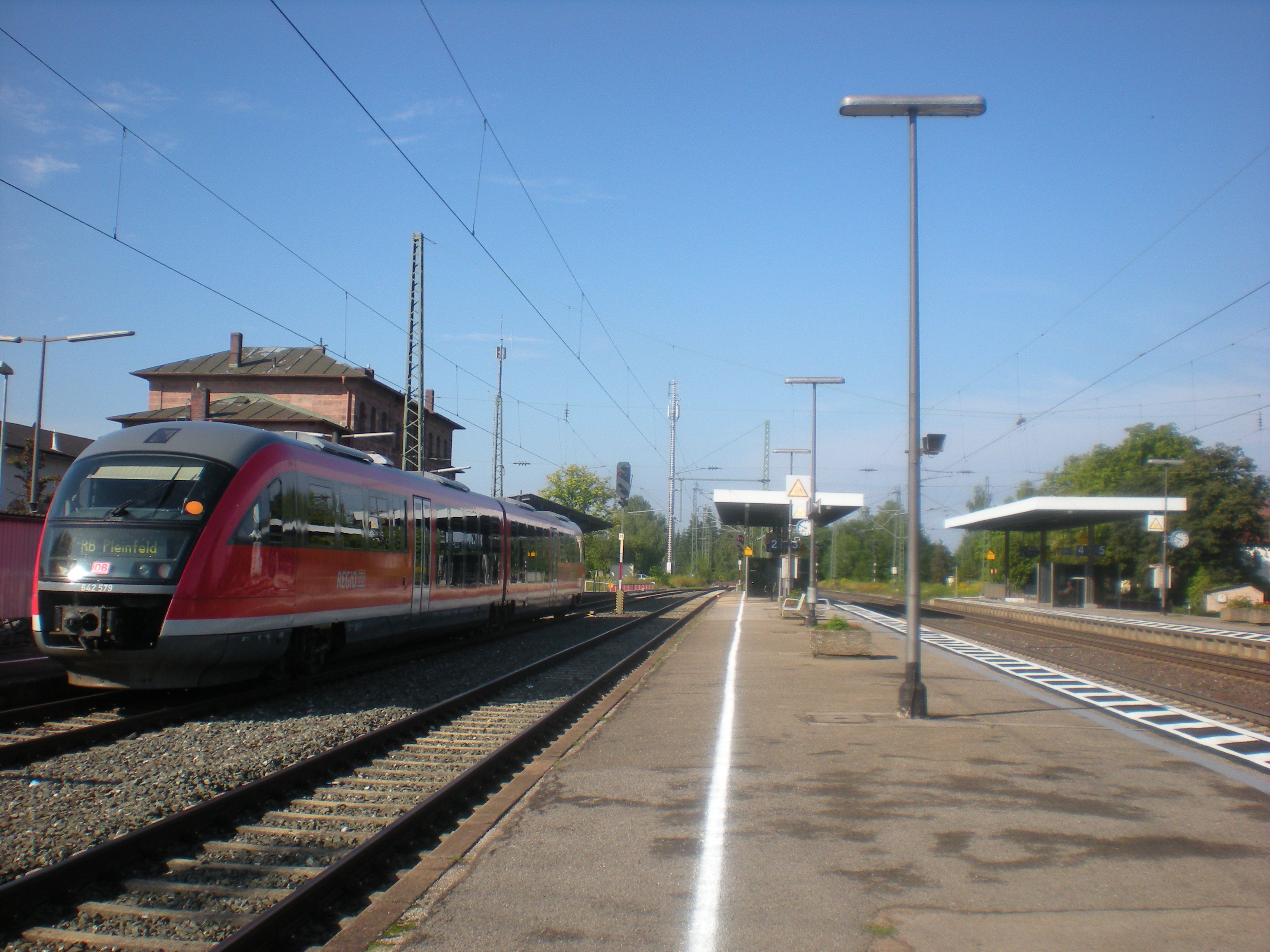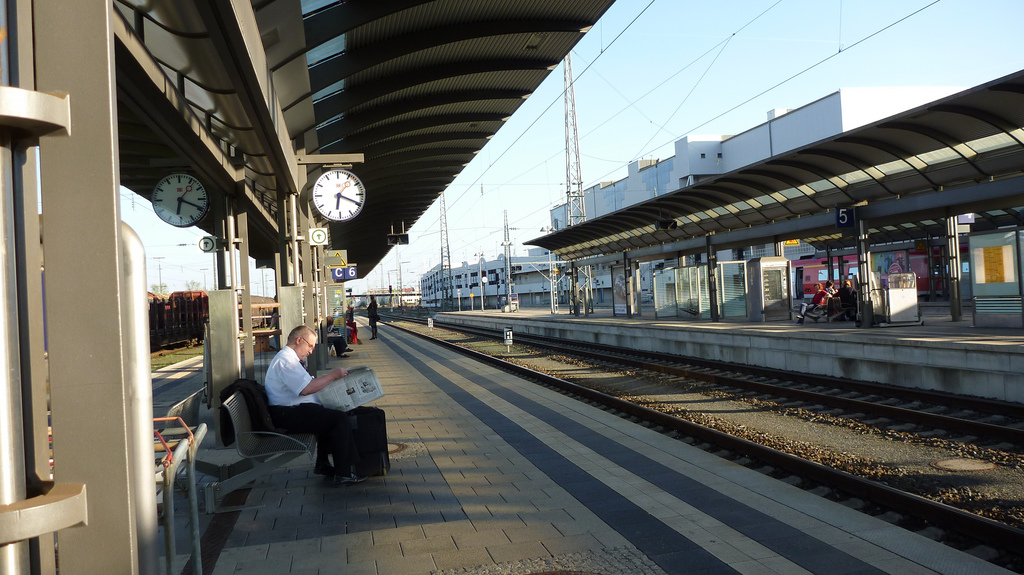|
Veitshöchheim Station
Veitshöchheim station is a regional railway station in southern Germany. It is at kilometre marker 7.0 on the Main-Spessart Railway from Würzburg to Aschaffenburg. It was built during the construction of Ludwig's Western Railway, which was taken fully into service on 1 October 1854. The station was built in the immediate vicinity of Schloss Veitshöchheim, a summer residenz initially of the prince bishops of Würzburg, later the kings of Bavaria, at Veitshöchheim near Würzburg. The castle is especially well known for its surrounding rococo garden. In the 19th century this park, which was then a public facility, was nearly destroyed by the construction of the railway. Engineers had planned to use the central avenue of the park for the trackbed of the railway. This idea was however vetoed by King Ludwig I, who ordered the line to be routed to the east around the castle gardens even though this was topographically less suited. This was also where Veitshöchhe ... [...More Info...] [...Related Items...] OR: [Wikipedia] [Google] [Baidu] |
Veitshöchheim
Veitshöchheim is a municipality in the district of Würzburg, in Bavaria, Germany. It is situated on the right bank of the Main, northwest of Würzburg. Veitshöchheim has a population just under 10,000. It includes two villages: Veitshöchheim and Gadheim Attractions Schloss Veitshöchheim :de:Schloss Veitshöchheim is located in the town. This summer palace of the Prince-Bishops of Würzburg was built in 1680–82, and was enlarged to its present appearance in 1753 by Balthasar Neumann. The gardens were redesigned for Prince-Bishop Adam Friedrich von Seinsheim (1755–1779), with lakes and waterworks, and filled with hundreds of allegorical sandstone sculptures from the workshops of the court sculptors Ferdinand Tietz and Johann Peter Wagner. Infrastructure Transport Veitshöchheim has a railway station near the Schloss with a former royal pavilion. Partner towns * Rotava, Karlovy Vary Region The Karlovy Vary Region or Carlsbad Region ( cs, Karlovarský kraj, Ger ... [...More Info...] [...Related Items...] OR: [Wikipedia] [Google] [Baidu] |
Rococo
Rococo (, also ), less commonly Roccoco or Late Baroque, is an exceptionally ornamental and theatrical style of architecture, art and decoration which combines asymmetry, scrolling curves, gilding, white and pastel colours, sculpted moulding, and '' trompe-l'œil'' frescoes to create surprise and the illusion of motion and drama. It is often described as the final expression of the Baroque movement. The Rococo style began in France in the 1730s as a reaction against the more formal and geometric Louis XIV style. It was known as the "style Rocaille", or "Rocaille style". It soon spread to other parts of Europe, particularly northern Italy, Austria, southern Germany, Central Europe and Russia. It also came to influence the other arts, particularly sculpture, furniture, silverware, glassware, painting, music, and theatre. Although originally a secular style primarily used for interiors of private residences, the Rococo had a spiritual aspect to it which led to its widespread us ... [...More Info...] [...Related Items...] OR: [Wikipedia] [Google] [Baidu] |
Railway Stations In Germany Opened In 1854
Rail transport (also known as train transport) is a means of transport that transfers passengers and goods on wheeled vehicles running on rails, which are incorporated in tracks. In contrast to road transport, where the vehicles run on a prepared flat surface, rail vehicles (rolling stock) are directionally guided by the tracks on which they run. Tracks usually consist of steel rails, installed on sleepers (ties) set in ballast, on which the rolling stock, usually fitted with metal wheels, moves. Other variations are also possible, such as "slab track", in which the rails are fastened to a concrete foundation resting on a prepared subsurface. Rolling stock in a rail transport system generally encounters lower frictional resistance than rubber-tyred road vehicles, so passenger and freight cars (carriages and wagons) can be coupled into longer trains. The operation is carried out by a railway company, providing transport between train stations or freight customer facili ... [...More Info...] [...Related Items...] OR: [Wikipedia] [Google] [Baidu] |
Treuchtlingen Station
Treuchtlingen station is now the only station in the town of Treuchtlingen in the German state of Bavaria. The town used also to have stations at Graben, Möhren, Gundelsheim and Wettelsheim. Treuchtlingen station has seven platform tracks and it is classified by Deutsche Bahn as a category 3 station. The station is served by about 110 trains daily operated by DB Regio and DB long-distance. The station is a railway junction on the Nuremberg–Augsburg, Ingolstadt–Treuchtlingen and Treuchtlingen–Würzburg lines. Location The station is located in northern Treuchtlingen. It is bordered to the west by Wettelsheimer Straße and to the east by Bahnhofsstraße, which is also the location of the entrance building. A bridge connects these streets south of the premises of the railway station. The address of the station is 61 Bahnhofsstraße. History Treuchtlingen station was opened on 2 October 1869 together with both the Ansbach–Treuchtlingen section of the line to Würzburg a ... [...More Info...] [...Related Items...] OR: [Wikipedia] [Google] [Baidu] |
Gunzenhausen Station
Gunzenhausen station is apart from Cronheim station on the Nördlingen–Gunzenhausen railway, now operated as a heritage railway, the only station in the Bavarian town of Gunzenhausen and a hub of Middle Franconia. It is classified by Deutsche Bahn as a category 4 station. and has five platform tracks. The station is served by about 60 trains daily operated by Deutsche Bahn, and is served by the Treuchtlingen–Würzburg railway. The Gunzenhausen–Pleinfeld railway (also known as the ''Seenlandbahn'' or "Lakeland railway") and the Nördlingen–Gunzenhausen line, which is served by steam-hauled services on some days, also begin in Gunzenhausen. Location The station is located to the north of the centre of Gunzenhausen. The station building is located on the station forecourt (''Bahnhofplatz'') at the ends of Bahnhofstraße and Schillerstraße. Ansbacher Straße passes under the tracks to the west of the station. Alemannenstraße is to the north of the tracks. The station ha ... [...More Info...] [...Related Items...] OR: [Wikipedia] [Google] [Baidu] |
Ansbach Station
Ansbach station is the central transportation hub in the town of Ansbach in southern Germany. It is here that two main lines cross: the Nürnberg–Crailsheim and Treuchtlingen–Würzburg railways. History Ansbach was first connected to the railway network by a leased railway, that linked the town to the Ludwig South-North Railway at Gunzenhausen 28 kilometres away and which was opened on 1 July 1859. In 1869, the railway was open all the way from Würzburg to Treuchtlingen and, in 1875, it was joined by the line from Nuremberg, which was extended over the state border to Crailsheim in 1876. In 1903, the Leutershausen-Wiedersbach–Bechhofen railway was opened, whose trains were nicknamed ''Boggala'' in the Bechhofen dialect, and usually ran through to Ansbach. However it was closed as early as 28 November 1966. With the establishment of the Nuremberg Regional Transport Union (''Verkehrsverbund Großraum Nürnberg'' or ''VGN'') the line to Nuremberg was integrated ... [...More Info...] [...Related Items...] OR: [Wikipedia] [Google] [Baidu] |
Bamberg Station
Bamberg station is the only passenger station of the city of Bamberg in Upper Franconia in the German state of Bavaria. It is a major hub station for local trains operated by Deutsche Bahn and Agilis and is also a regularly served by Intercity-Express and Intercity trains. The station is on the Nuremberg–Bamberg, Bamberg–Hof and Bamberg–Rottendorf railway lines. It has seven platform tracks and is classified by Deutsche Bahn as a category 2 station. It is the northern terminus of line S1 of the Nuremberg S-Bahn. Location The station is located in eastern Bamberg, northeast of the Regnitz. On its perimeter are the streets of Ludwigstraße to the west, Starkenfeldstraße to the south, which crosses the rail tracks on a bridge, Brennerstraße to the east and Zollnerstraße to the north, which runs in an underpass under the tracks. Luitpoldstraße connects the inner city with Ludwigstraße opposite the station forecourt. The station building is located west of the r ... [...More Info...] [...Related Items...] OR: [Wikipedia] [Google] [Baidu] |
Schweinfurt Hauptbahnhof
Schweinfurt Hauptbahnhof is the largest railway station in the Lower Franconian city of Schweinfurt and its transfer hub to the majority of regional buses. In addition to the Hauptbahnhof, the Schweinfurt Mitte (Schweinfurt Central) and Schweinfurt Stadt (Schweinfurt Town) stations also lie within the city, closer to the centre, on the Bamberg–Würzburg railway. Importance The station is no longer served by long-distance traffic since the introduction of the Interregio line from Stuttgart via Würzburg and Schweinfurt to Erfurt in 2001. It still has an important role, however, in regional and local rail services. There are currently passenger services on the following lines: * ''KBS 803'' (Schweinfurt–) Bad Kissingen–Gemünden (Main) ( Franconian Saale Valley Railway), single-tracked main line * ''KBS 810'' Würzburg–Schweinfurt–Haßfurt–Bamberg ( Bamberg–Würzburg railway), double-tracked main line * ''KBS 815/570'' Schweinfurt–Bad& ... [...More Info...] [...Related Items...] OR: [Wikipedia] [Google] [Baidu] |
Würzburg Central Station
Würzburg (; Main-Franconian: ) is a city in the region of Franconia in the north of the German state of Bavaria. Würzburg is the administrative seat of the ''Regierungsbezirk'' Lower Franconia. It spans the banks of the Main River. Würzburg is situated approximately east-southeast of Frankfurt am Main and approximately west-northwest of Nuremberg (). The population (as of 2019) is approximately 130,000 residents. The administration of the ''Landkreis Würzburg'' ( district of Würzburg) is also located in the town. The regional dialect is East Franconian. History Early and medieval history A Bronze Age (Urnfield culture) refuge castle, the Celtic Segodunum,Koch, John T. (2020)CELTO-GERMANIC Later Prehistory and Post-Proto-Indo-European vocabulary in the North and West p. 131 and later a Roman fort, stood on the hill known as the Leistenberg, the site of the present Fortress Marienberg. The former Celtic territory was settled by the Alamanni in the 4th or 5th century a ... [...More Info...] [...Related Items...] OR: [Wikipedia] [Google] [Baidu] |
Gemünden (Main) Station
Gemünden (Main) station is a station in the town of Gemünden am Main in the Main-Spessart district of the German state of Bavaria on the Flieden–Gemünden railway. It was opened on 1 October 1854. The station is classified by Deutsche Bahn (DB) as a category 4 station. Station category After the completion of the Hanover–Würzburg high-speed railway, the station, which had previously been classified as a "regional node" (category 3), was downgraded to category 5 ("local traffic stop"), of the then six categories because from that time nearly all intercity services were routed over the high speed line. Up to the timetable of 2008 there were still occasional Intercity InterCity (commonly abbreviated ''IC'' on timetables and tickets) is the classification applied to certain long-distance passenger train services in Europe. Such trains (in contrast to regional, local, or commuter trains) generally call at ma ... services, but since then long-distance services have been ab ... [...More Info...] [...Related Items...] OR: [Wikipedia] [Google] [Baidu] |
Schlüchtern Station
Schlüchtern station is a station for trains. It is in the town of Schlüchtern in the German state of Hesse on the Frankfurt–Göttingen railway. The station is classified by Deutsche Bahn (DB) as a category 4 station. History The station was opened on 15 December 1868 along with the Neuhof– Steinau (Straße) section of the Frankfurt–Göttingen railwaFrankfurt–Bebra railway, which was established by the Landgraviate of Hesse-Kassel, the Grand Duchy of Hesse and Free City of Frankfurt, but was confiscated by the Prussian government following the War of 1866. Station facilities Platforms The train station has 4 platform tracks, a "home" platform (that is next to the station building), an island platform and a side platform. The home platform (platform 1) is only used by Regionalbahn services running on the Schlüchtern–Jossa– Gemünden–Würzburg route, which begin and end here. The central platform (tracks 2 and 4) is used by Regional-Express services on the Fra ... [...More Info...] [...Related Items...] OR: [Wikipedia] [Google] [Baidu] |




